
Over the 89 years that it was worked the ownership of this colliery was rather complex, starting as an unincorporated company in 1875 and ending as a nationalised company in 1947 before it closed in 1964. Colloquially, this colliery was also referred to as the Snipe Pit.
On the 14 March 1875 the first sods of ‘Stamford Pit’, as it was initially called, were cut on the south side of Manchester Rd, Ashton-u-Lyne, on the opposite side of the Rd to the Snipe Inn, Audenshaw. They were cut by Mr Hall, agent of the Earl of Stamford and Warrington the landowner and owner of the mineral rights, accompanied by the proprietors; John Greenwood, Joseph Walker, Benjamin Whitworth, Robert Whitworth, Mr H K Balston, Mr Broomhurst and Mr Eccles. At this time the earl was George Grey, 7th Earl of Stamford, his full title being George Harry Booth-Grey (1827-83), 7th Earl of Stamford (1845-83) and 3rd Earl of Warrington.
Once the viability of mining coal was proved Ashton Moss Colliery Co Ltd was incorporated in 1877 (Company No. 25050) and coal winding commenced in 1881/82. Nonetheless, some operational difficulties were encountered and in 1894 this company was voluntarily wound up and in 1895 the New Moss Colliery Ltd was incorporated (Company No. 43879).
By 1896 it was recorded that there were 50 underground workers and eight surface workers and that the productive Great and Roger Mines were being worked. Eventually, the shafts at this colliery were among the deepest in the country, for example, the Six-foot Mine was worked at 925 yards deep and the Four-foot (Black) Mine was worked at 960 yards. Over the years the mines worked were: Four-foot (Black), Six-foot, Great, Roger, Colonel, Mary, King and Town Lane.
The 1901 census records Thomas Herbert Wordsworth as the colliery manager and mining engineer, John Stevenson as the under manager and John Stevenson’s son, Arthur Stevenson, as an underground colliery foreman. Thomas Herbert Wordsworth was resident at York Place, off Richmond St, Ashton-u-Lyne, with his two sisters and John Stevenson was resident on Crowthorn Ln, off Manchester Rd, Ashton-u-Lyne, with his wife and family.
In 1922 the colliery was restructured and Ashton Moss Colliery Ltd was incorporated (Company No. 182368). In 1928 it was resolved that this company should be voluntarily wound up and the accountant, Tom Millward Fish, was appointed as the liquidator. Consequently, by 1930 the colliery had been taken over by the Chamber Colliery Company Ltd of Oldham (Company No. 11821, incorporated in 1877). This company worked Ashton Moss Colliery in combination with Woodpark Colliery (1836-1955) of Ashton Rd, Bardsley, Oldham, and Oak Colliery (Victoria and Albert Pits, 1848-1956) of Hollins Rd, Oldham. On the 1 Jan 1947 all Britain's collieries were nationalised and a statutory corporation called the National Coal Board (NCB) was created to run the nationalised coal mining industry.
Coal from the colliery was distributed by road, railway and the Ashton Canal. The colliery was connected by a tramway system to the London & North Western Railway (Guide Bridge Junction Line) and to the Oldham, Ashton & Guide Bridge Junction Railway via a tramway bridge over the canal adjoining Hanover Street North Bridge (aka China Bridge). There was also a connection to the Ashton Moss Colliery Loading Stage of the Ashton Canalin the vicinity of Hanover Street North Bridge. During ownership by the Chamber Colliery Co Ltd, a number of boats were operated by this company to carry coal to mills and factories along the canal.
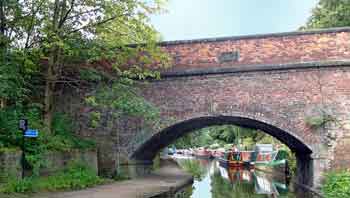
Hanover Street North Bridge looking west.
The tramway bridge was on the far side.

Lamp checks from Ashton Moss Colliery during four periods of ownership.
From left to right: Ashton Moss Colliery Co Ltd, New Moss Colliery Ltd, Chamber Colliery Co Ltd and the National Coal Board.
Ashton Moss Colliery merged with Bradford Colliery off Forge Ln, Bradford, Manchester (about 3.1 miles distant), in September 1959 but it was still used for winding purposes until c.1964. To facilitate this merger a horizon tunnel was driven between the two collieries so that coal from Ashton Moss Colliery could be taken underground to Bradford Colliery for washing and grading. Following its closure, the site was cleared and replaced by the Snipe Retail Park.
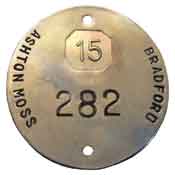
Bradford & Ashton Moss Collieries lamp check.
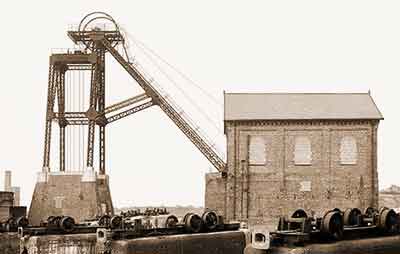
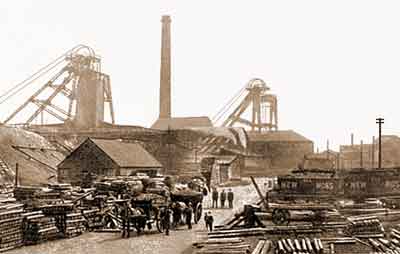
Ashton Moss Colliery, early 20th century.
Ashton Moss Colliery, early 20th century.
The two coal waggons on the right are in the livery of New Moss Colliery Ltd.
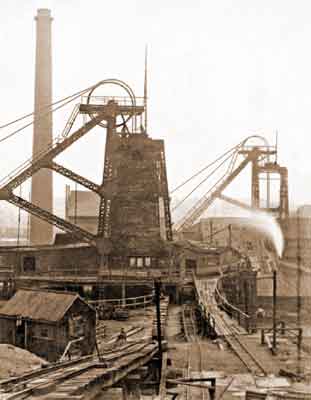
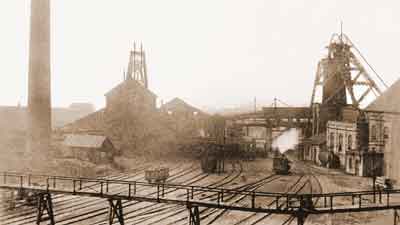
Ashton Moss Colliery, c.1914.
The downcast shaft is on the right and the upcast shaft is on the left. The tramways in the foreground were used for waste disposal on nearby spoil heaps.
Ashton Moss Colliery looking westwards, early 1920s.
The sidings in the foreground connected to the London & North Western Railway, Guide Bridge Junction Line.
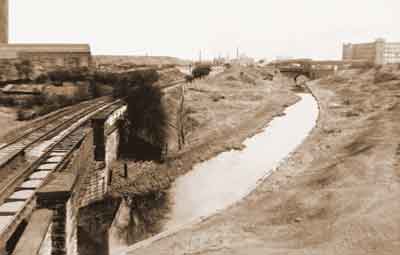
Hanover St (or China) Bridge, 1960s.
This bridge is in the background and it is viewed looking eastwards along the Ashton Canal from Groby Rd. The railway is the London & North Western Railway (Guide Bridge Junction Line). The Ashton Moss Colliery Loading Stage was in the vicinity of this bridge. A tramway bridge crossed the canal on the nearside of the bridge and the tramway followed Hanover St to terminate at the Oldham, Ashton & Guide Bridge Junction Railway. The mill on the right is York Street Mill.